Vänersborg's maritime history (engelska)
[Deutsch] [English] [Français] [Nederlands] [Svenska]
- Maritime navigation up until 1916
The beaches and the land surrounding the large Lake Vänern have throughout history attracted settlers. Hunting, fishery, and an agricultural culture that originated at an early stage, made this area very popular. The only means of drainage for this large lake is the which, with its large waterfalls, has posed a hindrance for all contacts with areas to the South, and provided a natural form of protection against enemy attackers.
Lake and river have for centuries linked remote parts of the country. Vänern's importance as a cohesive force, also for trade and culture, cannot be denied. In the old parish of Vassända, at the southernmost tip of Vänern, the most important medieval roads met. One came from the East, from the inlands of Västergötland, and leading towards the West and neighbour , at a distance of no more than 30 km. The other one linked the cities in the South along the coast with the areas located further up North, such as Dalsland and Värmland. However, the most important one was the road that in olden days was called Gamlastigh, later known as the Edsvägen, that lay between the southernmost tip of Vänern and the town of , south of the large waterfalls in Trollhättan.
Vasa to name Brätte
At such an intersection of traffic and goods, it is natural that trade and market places will be established. This particular one was given the name Brätte by Gustav Vasa in 1550. However, it's considered to be quite certain that this market place existed long before it received its name.
People from all parts of the country were attracted to this market, and brought salt, herring, broadcloth, imported goods or wood, tar, grains, livestock, butter, hides, leather, and all other types of wares that miners and farmers could supply. But it was the iron that got Brätte to develop and obtain town status in 1603. The iron was produced at the mills north of Vänern, and the major part was intended for export. Maritime freight became a necessity, and at Brätte, one sailed as far up as possible. Here, the iron had to be transferred onto horse-drawn carriages and later carts, and the ”Edskörseln (transport along the river the Ed)” came about. This form of transport has been mentioned at an early stage, both for its hard and difficult transport conditions, as well as for the large volumes that were transported.
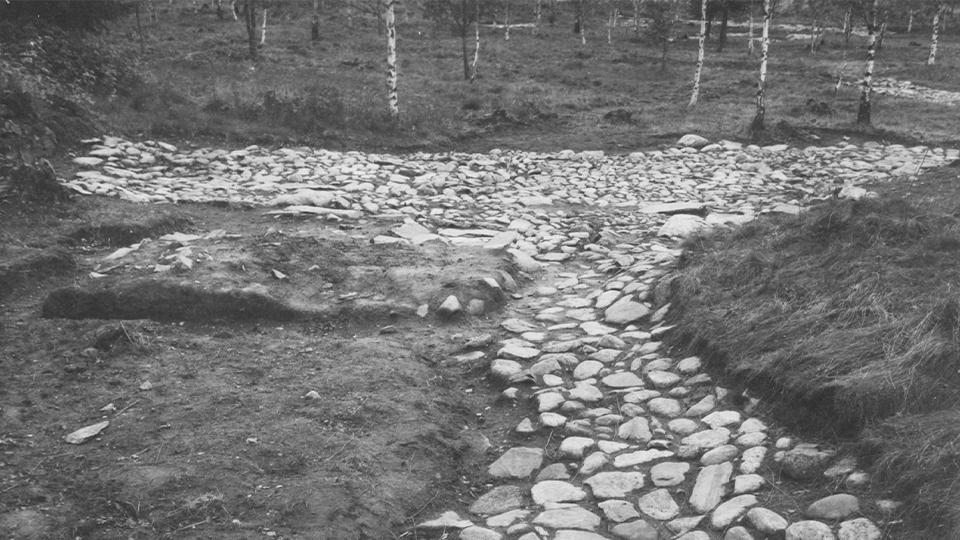
Photo of the Edskörsel road (from the excavations at Brätte in 1943)
During the 1640's, citizens said to own 200 horses and carriages. Added to this were the horses and carriages the county's farmers owned and with which they also participated in this form of transport. In total, up to 200 tonnes of iron, and a large amount of goods in barrels were transported on this road on a daily basis.
Toll fees were important
The transport was conditioned by the natural circumstance that the upper leg of the river couldn't be used by ships. The road constituted the lifeblood of Brätte, and later of Vänersborg. The town's existence depended on the iron exports from Värmland.
The citizen's income didn't chiefly come from trade, as revenues were modest. However, considerable ”toll fees” were paid on all goods that arrived in the town, such as iron, pitch, herring and talcum. These monies were the town's treasury's main asset, along with the rent money for sheds, taxes and fees for passing ships.
The Edskörseln was something unique for Vänersborg. All, whether mayor or priest, down to the poorest in the community, were more or less involved in it and earned their livelihoods mostly with this activity.
Town moved for several reasons
Due to political, military strategic and natural conditions, Brätte was to become defunct and replaced by a new town that was to be built some kilometres to the North. The Crown (State) acquired the property Huvudnäs and granted the Vänersborg town status in 1644.
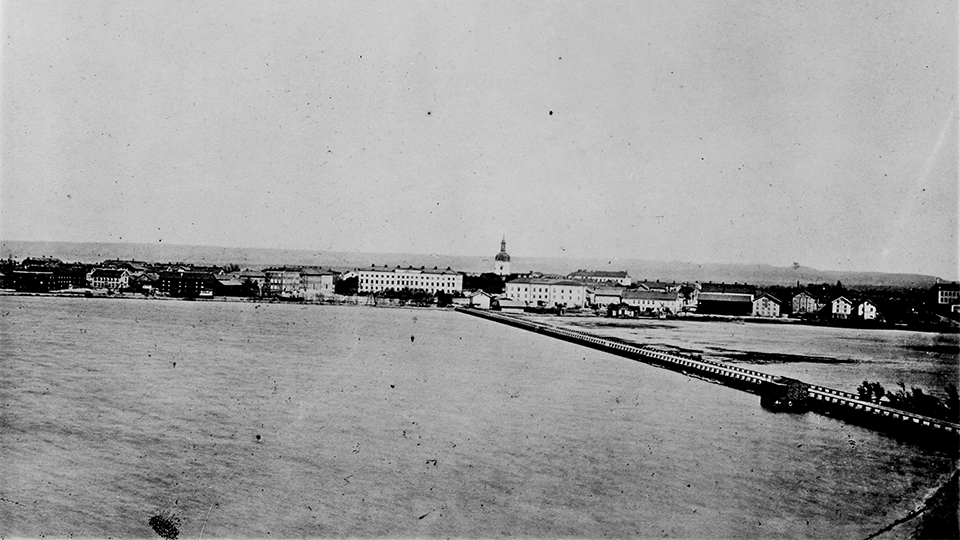
An old photo of Vänersborg and the Dalbobron, ca. 1870
Trans-shipment activities were maintained for some years at Brätte, but larger vessels and shoaling of the inner part of the bay caused the trans-shipment activities, sheds and the railway to be moved to Korseberg in 1670.
In earlier times, there were hardly any aids available for the navigation of Vänern. One sailed on natural points of recognition, and made notes in special notebooks that were handed down throughout the generations.
Only at the end of the 1700's, a start was made with surveying Vänern, and in 1789, the Kungliga Amiralitetskollegiet (the Royal Admiralty College) published the first charts of Vänern. In 1799, the ”Direktionen öfver Seglatjons förbättrande på Sjön Wenern (Board for the Improvement of Vänern)”, since called the Vänerns seglationsstyrelse (Vänern's Sailing Board), was founded. It still exists today. It's task is partly to provide training for seafarers in navigation, based on charts and compass, and partly to build and maintain lighthouses, as well as to place buoys and beacons.
The idea for being able to freely navigate the Göta River all the way to the North Sea has long since had its advocates. Already Gustav Vasa had such thoughts, as did Karl IX. The works at Karls grav, in the beginning of the 17th. century, support this notion. The relentless waterfalls at Rånnum constituted an insurmountable obstacle, and following the river's main stream was thought to be impossible. It was more opportune to follow Karls grav and to build locks at Brinkebergskulle. Already in 1718, Christopher Polhem started construction of a lock.
A lack of finances and the demise of Karl XII caused the project to be terminated. As late as in 1752, the first lock at Brinkebergskulle could be inaugurated. It was given the name ”Greve Tessin”. One year after the dredging of Karls grav, one could sail to Trollhättan in an unhindered fashion. ”Gustav's” new locks were taken into use twenty-five years later, and one year later, the first iron schooners could sail to Trollhättan. This concluded the first stage of the construction of the Trollhätte Canal.
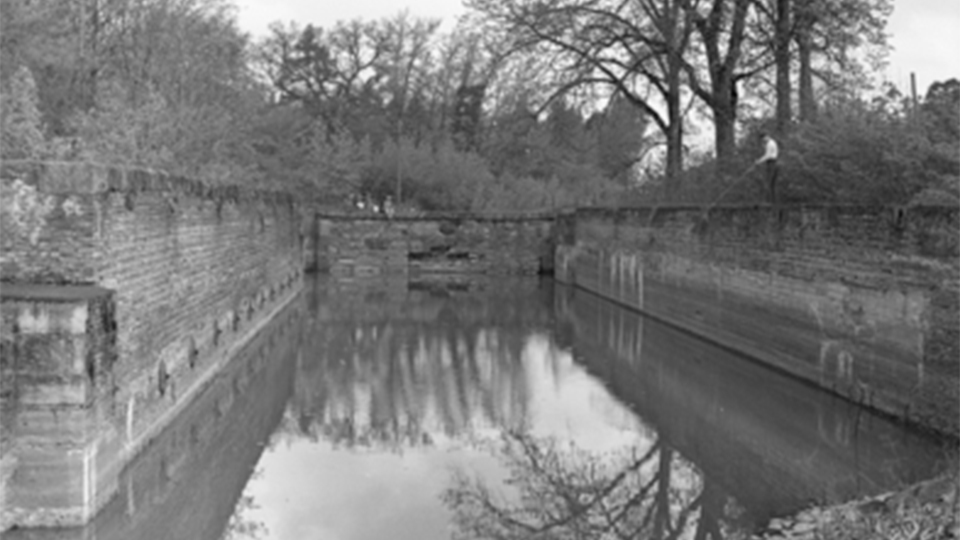
Gustav's brick locks
Animated discussions arose around the matter of which towns should be granted shipping rights for the canal. It was mostly the citizens in the staple town of , who turned against the inhabitants of Vänersborg in this matter. Broman defended the Älvsborg towns vis-a-vis Gothenburg. Broman was of the opinion that the objective of founding Vänersborg and Åmål had been that goods from and to Bergslagen ”could be transported with ease via Vänern in order to ascertain the maintenance of the inhabitants of the towns involved”. The people of Vänersborg argued vehemently that the inhabitants of Gothenburg would not be awarded the chance of dominating shipping on the new waterway.
The canal works progressed and, while the construction of the remaining locks was still underway, a 3 kilometre long wooden bridge was added to the new lock at Åkerström, to serve as a haul road between the Kavlebron (approximately where hotel Hotell Swania is situated today) and Åkersvass. This combined land- and waterway served until 1800, when the was inaugurated and Vänern thus had obtained a direct waterway connection with Gothenburg.
The age-old Edskörselns saga had now run its course. The farmers that were living along the Ed, who ”previously made a living with iron bars, were now reduced to beggars”.
Two large markets
During the autocracy, towns were classified as staple towns or as northern towns, whereby only the first were allowed to do business with other countries. In , this was only Gothenburg. Moreover, it was prohibited for a person from Vänersborg to conduct trade activities with tradesmen from the staple towns, to the same extent as it wasn't allowed for the latter to establish business contacts in Vänersborg.
The town's commercial freedom of action on the internal market was highly limited. It was only on two occasions that free competition with Gothenburg and other towns' citizens was possible. Those were the two large markets, the Kyndel fair (2. February) and the Mor fair (8. September).
In the case of the edskörseln, only foremen could generate an income. Tradesmen could do so by providing an intermediary link for trade with Gothenburg. Such an agent for the trading houses in the staple towns were called factors, and their task was to monitor, mediate and organise transport services for the owners' products.
For his services, a factor either obtained part of the goods or a percentage of their resale value. Very often, they themselves were trading goods on the side. They were very thorough in guarding their acquisitions and tried in all possible ways to create a local monopoly for their activities.
Monopoly on toll charges
For Vänersborg, an unimpeded passage of Vänern was a condition for survival. Up until the opening of the Trollhätte Canal, the towns around Vänern held exclusive shipping rights, shipping in principle being the only business activity that could cover public spending. It was expected that now, competition would increase, and governors feared that they would not be allowed to hold onto received fees and taxes.
Surrounded by trade restrictions and fierce competition from surrounding towns, monopolies, franchises on certain goods and the exclusion of other towns' vessels were common phenomena. Thus, Vänersborg held a monopoly on letting out stock sheds, franchises for fixed periods for the trade with masts, toll charges, a franchise for transports on the Edsvägen, and moreover, fees were charged for every vessel that passed into Vassbotten.
All stumps, unsawn tree logs and sawn wood that passed through the town, was taxed with a harbour fee. In order to safeguard transport orders, vessels were at certain times only allowed to transport cargo in one direction. As late as in 1803, free competition was introduced for cargo shipping, and in 1858, Vänersborg was granted staple town status. They could now conduct direct trade activities with other countries. Important export goods were grain, wood, iron and pit props.
Bojort included in the town's coat of arms
The oldest known vessel that was used for maritime freighting was the so-called block boat. It had a relatively deep draught, and was rigged with 1 - 3 masts with square sails. It was entirely open and built with clinkers, had a cabin for the skipper , and the crew had its place up front in the forecastle. It was used up until the 19th. century.
When Dutchmen and Germans, who had migrated to Gothenburg, obtained trading rights for Lake Vänern, other types of crafts started to be used, amongst others these bojorts. The hulls of these boats were flat underneath and had little draught. They were equipped with one mast and a square sail. Both Kristinehamn and Vänersborg included the bojort in their coat of arms.
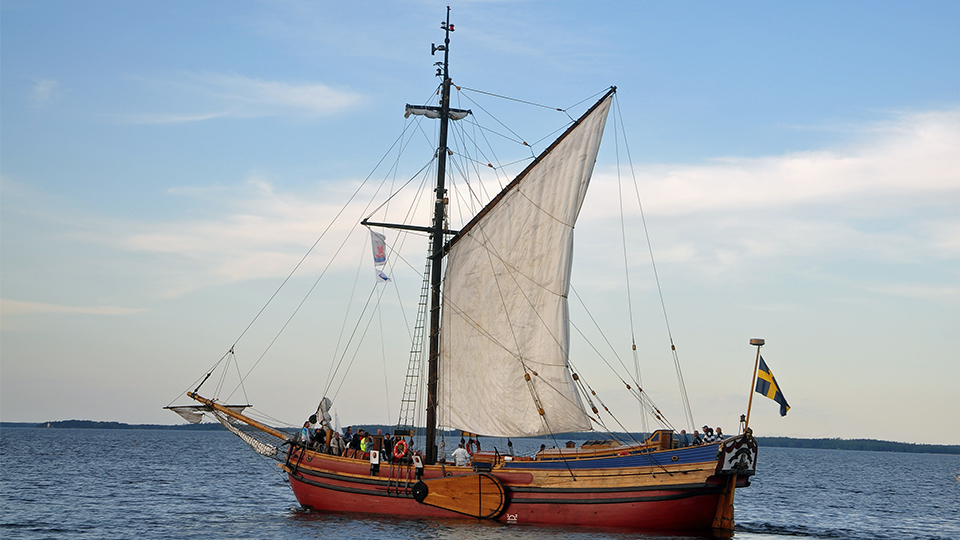
The bojort Christine af Bro, built in the bojort shipyard in Kristinehamn and launched in 2002
Shipping on Lake Vänern was revolutionised during the 1830's, when steamers were introduced. The first ones to be used, were paddle steamers. The first vessel to sail LakeVänern in 1833 was a tugboat, called Sleipner. Already in 1834, a type of paddle steamer was constructed, that had the paddle housings mounted in a way in which they didn't stick out on the sides. It was easier for these boats to pass through the narrow locks and moor directly onto a birth. A good example of this type of paddle steamer is the long since perished Eric Nordewall, of which a full-sized copy has been built, the Eric Nordevall II.
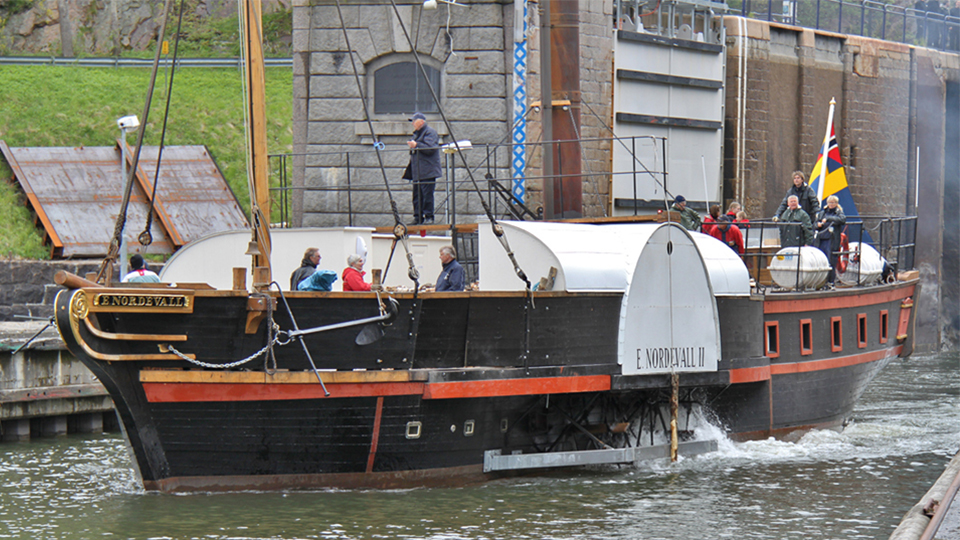
The paddle steamer Eric Nordevall II. Photo: Thomas Valeklint – Valeklint foto
The same year, the Stora Bolaget was founded for the operation of steamers between Gothenburg and Stockholm. Already 30 years later, the number of steamers that were out in traffic on a regular basis had gone up to around 40. Not only did the use of steamers increase, so did that of traditional sailing ships. The number of trips on the canal increased from around 2,500 during the 1830's to approximately 7,000, 30 years later.
The many shipping lines that came together at the inlet of the canal, turned the town into one of the most important nodes for domestic shipping. The variation in transported goods contributed to large-scale trans-shipment activities in Vänersborg and the harbour was in the process of developing into a trading post for the entire surroundings of Lake Vänern. Conditions led to a considerable expansion of shipping activities.
At the time of construction of the Trollhätte Canal, many works were being carried out around Vänersborg, most notably the dredging of the canal, the routing of towpaths, the jetties, and the exchange of the old drawbridge for a spindle bridge. The maintenance of all installations required for shipping proved to be a heavy burden for the town.
After deliberation with the Canal Board in 1825, it was decided that the town would be relieved for all times from maintaining all installations that were connected to shipping, as well as from maintaining the Dalbobron, which was a drawbridge.
The important grains trade
The most important thing that happened during the 1840's, with respect to Vänersborg's trade, was that the grains trade had meanwhile started to take on a wholesale character. Typical for this development was that the autumn market, which usually took place in September, was remanded to the end of October upon request of the tradesmen. Motivation for this request was that it was expected that by the end of October, the volume of threshed grains would be larger.
One tried to use the waterways as long as possible, in order to avoid the expensive road transports. Vänersborg proved to be the nearest port of shipment and was without compare the harbour that was used most by seed-producing mills in Dalsland as well as Västergötland. Part of the grain was shipped during the autumn, but the bulk was shipped to Vänersborg in wintertime, to be stored there until the ice melted. These shipments that were bound for England, with among others mining horses and carriages, caused an upturn for the entire sector.
The 1850's saw an additional growth in grains trade. The number of barrels that were shipped from the harbour increased from 16,000 in 1853 to 60,000 in 1856. Several tradesmen that were involved with these activities, made their fortunes. One of these was Johan Adolf Andersohn, founder of Vänersborg's Museum.
Shipbuilding flourished
In the 1830's, there was a rather large shipyard on Sanden south of the Dalbobron. Because of the towpaths that had been routed by the canal company, the shipyard was isolated from the strait and became unusable. The company offered to replace it by a new one in an agreed location to the East of what was called the Dyviken. Right from the start, this shipyard was used for the ship owners own fleets, but also for ships that were built with the intention to sell them.
Throughout the 1850's, shipbuilding was flourishing in the town. Instead of the old, difficult to manoeuvre Väner boats, lighter and more solid caravels were now being used, fast vessels that were mainly intended for salt water use. Typical for the Väner boats was that they had very high masts that were rigged with a top sail. When sailing the canal, this was necessary to extend above the tree tops in order to get wind in the sail. Shipbuilding was also found in other parts of the town, such as the Gropbron, Tenggrenstorp and Tackjärnsbacken on Blåsut.
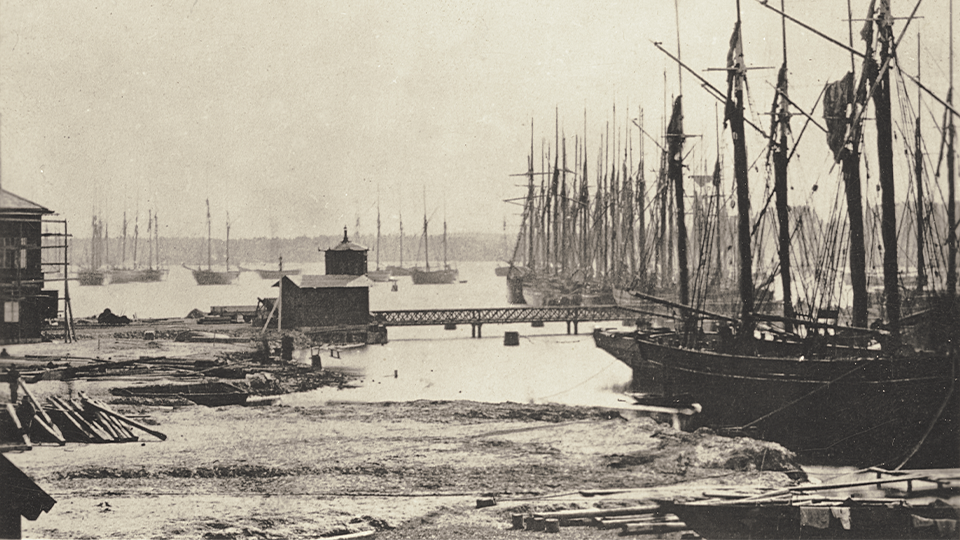
Vänersborg's harbour with remains of the shipyard at Dyviken to the left and the station building under construction, ca. 1865-1867
All in all, seven to eight larger vessels could be launched annually during the 1850's. These schooners, brigs and barques were highly appreciated. When some years later, the railway was extended through the town, the property of the shipyard in Dyviken was also needed, and it was closed down.
Requirement for a cook house
According to harbour regulations, it was prohibited to light fires on board of vessels that were moored in the harbour. The skippers, who in their own interests were aware of the dangers, when many ships were anchored in the port, now demanded the municipality would provide a "cook house", where seafarers could prepare food and dry their clothes. In 1838, a log house was constructed, that was thought to be financed by means of every vessel that called at the harbour having to pay fees, irrespective of whether they used the cook house or not. Within a short time, the cook house generated a considerable profit for the town.
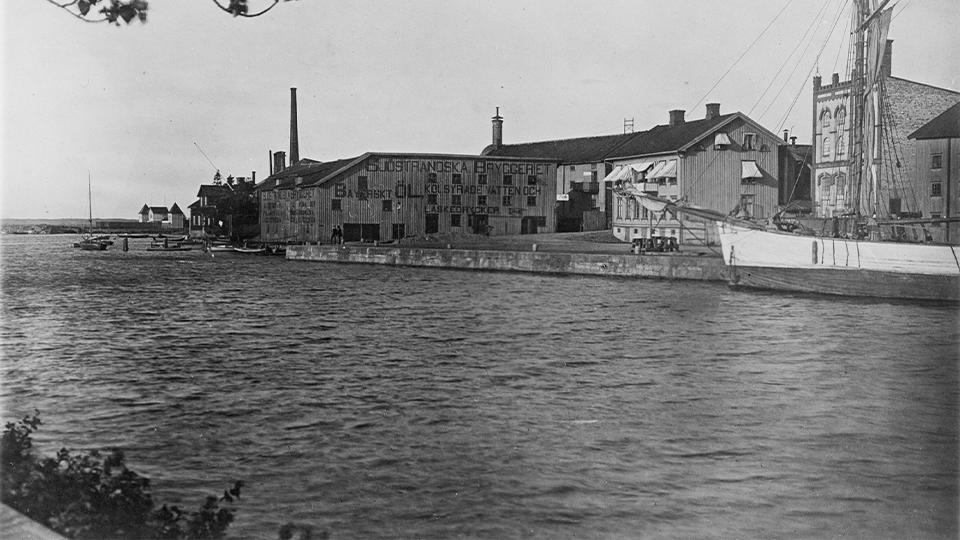
Along the water, to the left in the picture - outdoors bath house, cook house and the Sjöstrandska brewery
The Vänersborg harbour was of poor quality and in order to be able to provide more vessels with the possibility of loading and unloading here, it was decided in 1844 that the town would build proper quays. During the next 12 years, quays were constructed between the Sundsgatan and the Verkstadsgränd.
However, the efforts of the town to improve the harbour, were not sufficient for creating a safe and secure environment. Only after the third breakwater had been constructed around 1910, acceptable conditions could be realised.
Railways to break the dominance
During the 19th. century, maritime freighting played such a dominant role, it wasn't noted that railways, which were being developed in England and on the continent at a high pace, could also be of significant importance for the society in this country. The common opinion here was that railways could be regarded as an addition to maritime freighting.
Against this background, it was difficult to find a more suitable railway line from the southern tip of Vänerns to the Byfjorden in Uddevalla. The owners of the mills in Värmland recognised the advantages of avoiding high canal fees, the possibility of having transports all year round and, to a certain extent being able to break Gothenburg's monopoly position.
Already in 1862, the entire railway line between Gothenburg and Stockholm had become operational, and the canal's dominant role for passenger traffic had become a thing of the past. Vänersborg had once again been remanded to the periphery. It was therefore imperative to, as quickly as possible, obtain a connection with the fast growing railway network.
The people of Vänersborg saw the Uddevalla line as an opportunity, and thought the town could become a terminal for a major part of maritime freighting, which at that point wasn't passing through the town. Many goods could be transferred to the railway line to Uddevalla. Freight charges on the railways could be kept lower than those on the canal, and cargo could be delivered faster.
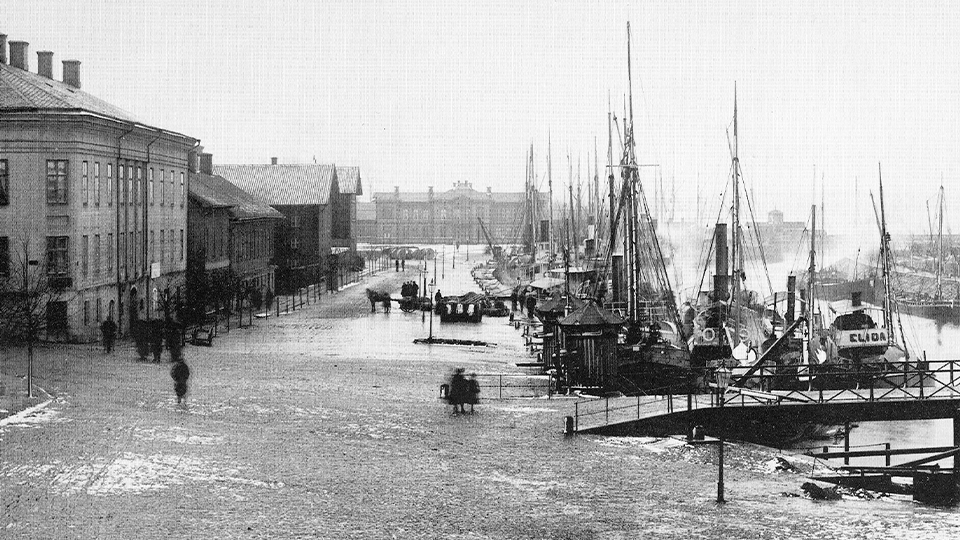
Steamers have taken over, new railway station building in the background, ca. 1890
In spite of the lack of interest from the part of the town, it was enforced that the new line would extend as far as Herrljunga, with a connection to the main line and a branch line from Borås, which was already under construction. All of this was completed in 1867.
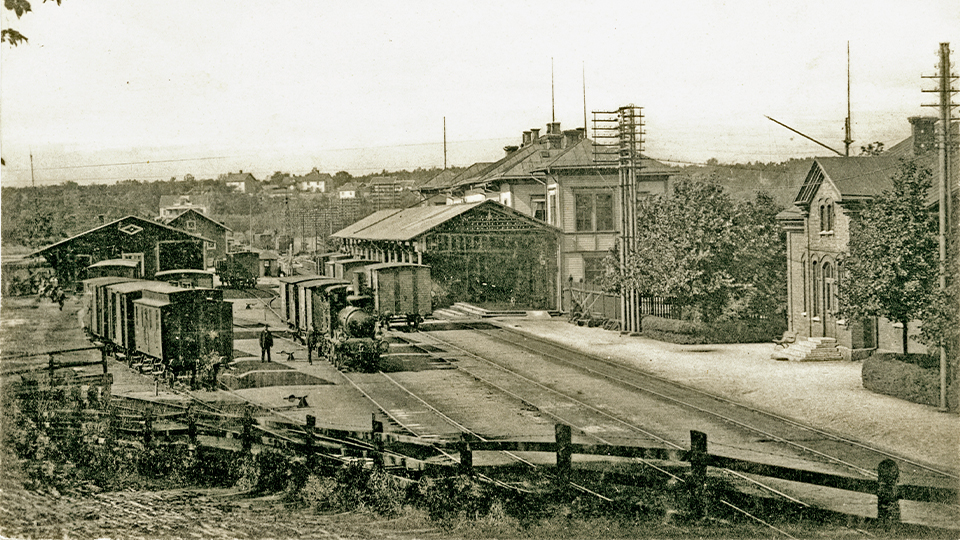
Railway station with auxiliary buildings
The reason for establishing Öxnered
The town's hopes, it would become apparent, were only to be fulfilled to a very limited extent. The new means of transport would soon play an independent role within the transport sector. In order to not have to endure another similar setback, the powers that be in Vänersborg adopted a different attitude towards the next major railway project, being the Bergslagsbanan, which was projected to connect Falun and Gothenburg.
In order to not compete with its own historic maritime freighting activities in the North, and perhaps missing out on the grains trade that was so important at the time, Vänersborg did not want the line to run through the eastern part of Dalsland, and under no condition to pass through Vänersborg. That is the reason for the station being erected at Öxnered. This is how short-sighted and with complete disregard for the future this important matter was dealt with. The line Öxnered - Gothenburg was inaugurated in 1878.
Trans-shipment activities of such large scale as the railway advocates had dreamt of, never developed in Vänersborg. As others had feared, the railways would severely encroach on the historic role of maritime shipping.
At the end of the previous century, little was left of the once so important shipping business in Vänersborg. The previously vivacious passenger traffic on the canal, which made a thoroughfare of Vänersborg, decreased and changed its character.
New canal open for traffic
However, it became apparent that there was still a demand for passenger vessels on the canal, both for line traffic as, more importantly, for tourism purposes, and in 1875 a new harbour office with a waiting room for passengers for the steamers, was built on the corner of Hamngatan-Sundsgatan. The use of sailing ships had become non-existent, and steamers dominated.
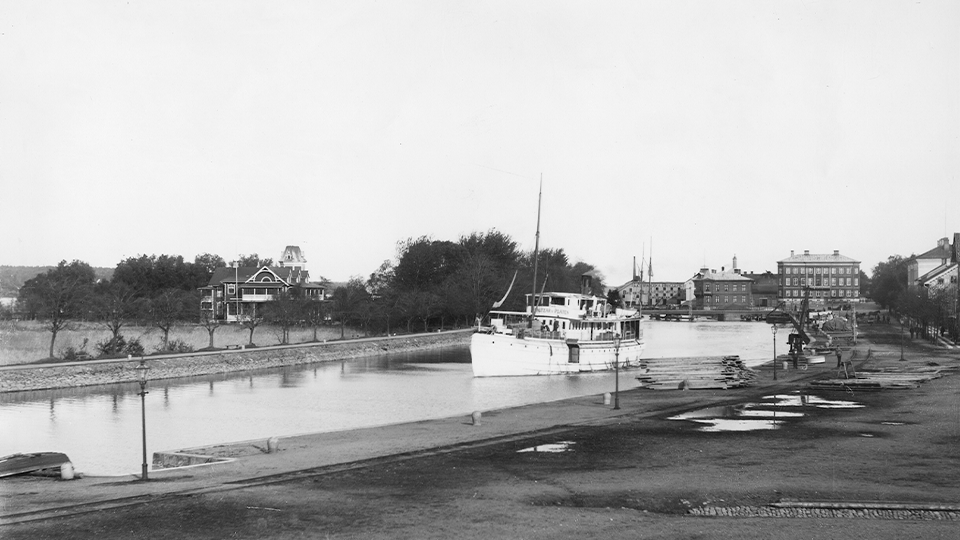
Carriage of passengers in the port channel, ca. 1900
After 1916, maritime freighting would also pass the town by completely. In the same year, the Nya Trafikkanalen (New traffic canal) was opened. It had a deep-water port, and was located approximately 500 metres to the West of the old port canal.
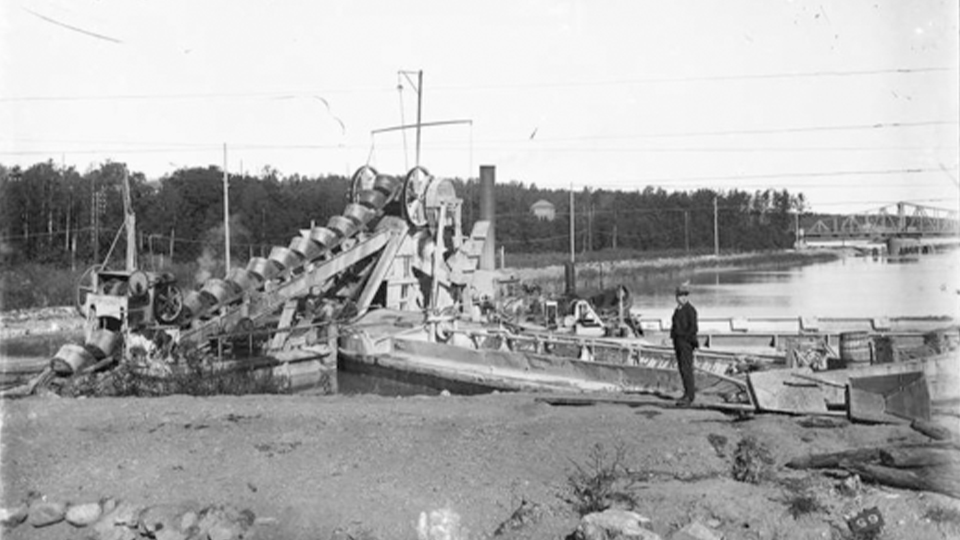
Dredging of the new port canal, ca. 1916
The old port canal ceased to be a thoroughfare, ant the canal was completely blocked off by means of two stationary bridges.
Therefore, the old strait, with its hundreds of years of shipping traditions, irreversibly stopped being a throughway. What kind of impact the new, modern, deeper harbour at the new traffic canal would have on Vänersborg's shipping activities and development, should be dealt with against a different background.
Background
The municipality of Vänersborg participates in the EU project MARIFUS, which has the objective to further economic growth. "Maritime Inlands – Past, Present and Future Strengths - MARIFUS" has set itself the objective to, from an experience economic perspective, shape traditional cultural maritime environments along the internal waterways and in peripheral areas along the Kattegatt/Skagerak, as attractive destinations within the North of Europe, by creating a cross-border platform for co-operation between different parties along the Limfjorden, the Vendsyssels Kattegatt coast, the Trollhätte Canal and Lake Vänern.
The project's objectives include:
- Cultural maritime environments as areas for development - durable and attractive places to visit, and a type of development that both improves the quality of the cultural maritime environments, as well as their attractiveness.
- Innovative development of destinations - an improved attractiveness of the traditional cultural maritime environments in the shape of experiences, events and entrepreneurship, which can lead to new business opportunities, companies and employment in the tourist sector.
- Profiling and communication - Profiling and communication with respect to traditional cultural maritime environments along the internal waterways and in peripheral areas as being attractive destinations, located in the heart of the region.
For the EU project MARIFUS,
Per Hedqvist, Christer Zetterberg och Per-Ola Rasmussen
Sidinformation
- Senast uppdaterad:
- 2 februari 2023
